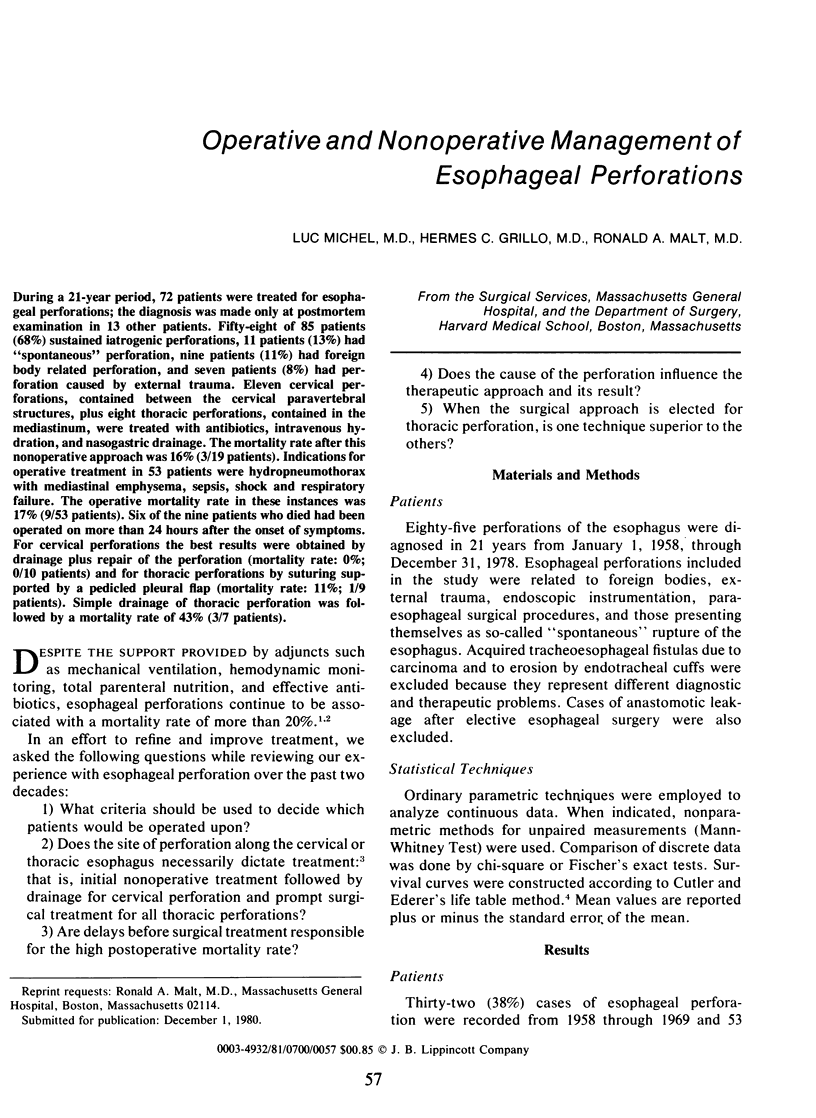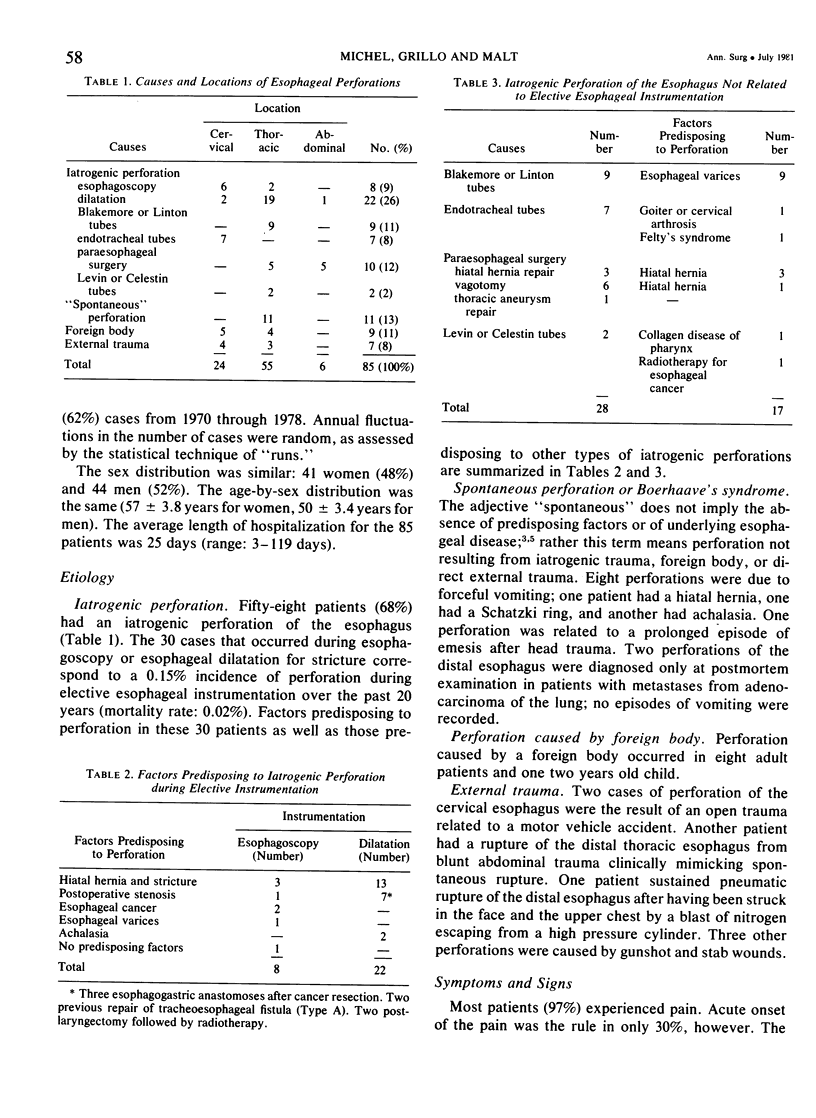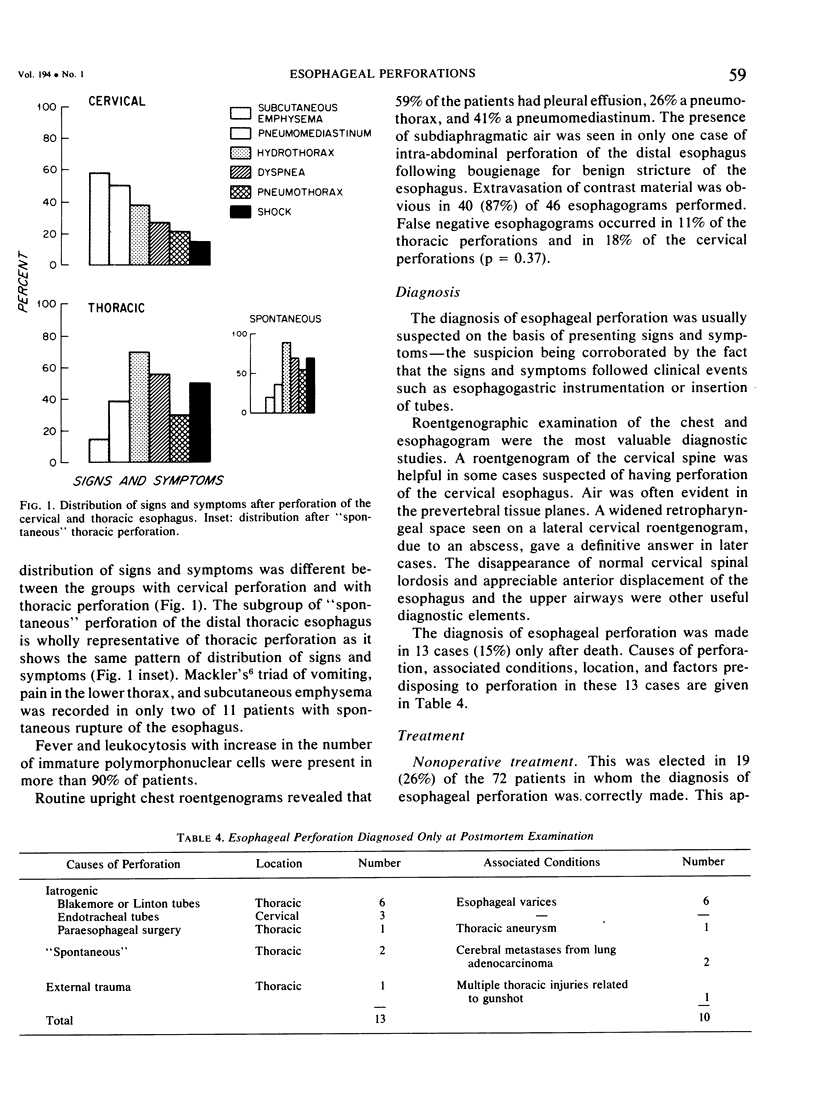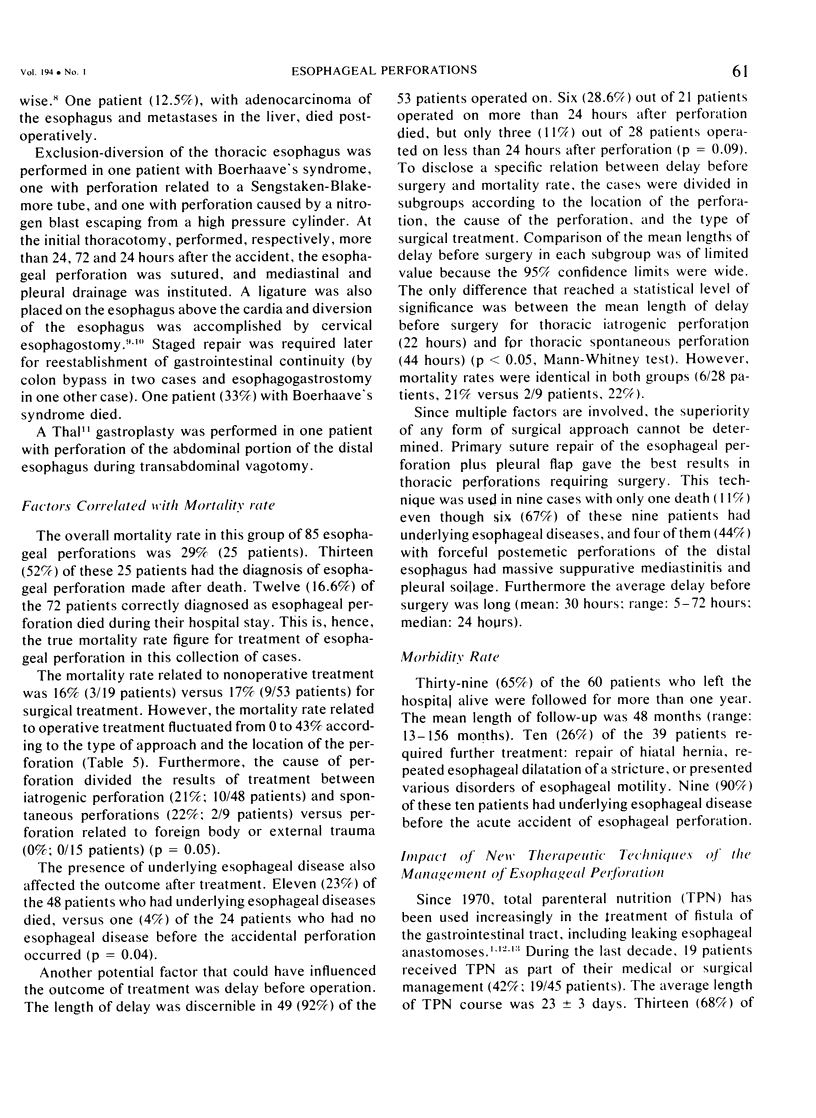Abstract
During a 21-year period, 72 patients were treated for esophageal perforations; the diagnosis was made only at postmortem examination in 13 other patients. Fifty-eight of 85 patients (68%) sustained iatrogenic perforations, 11 patients (13%) had "spontaneous" perforation, nine patients (11%) had foreign body related perforation, and seven patients (8%) had perforation caused by external trauma. Eleven cervical perforations, contained between the cervical paravertebral structures, plus eight thoracic perforations, contained in the mediastinum, were treated with antibiotics, intravenous hydration, and nasogastric drainage. The mortality rate after this nonoperative approach was 16% (3/19 patients). Indications for operative treatment in 53 patients were hydropneumothorax with mediastinal emphysema, sepsis, shock and respiratory failure. The operative mortality rate in these instances was 17% (9/53 patients). Six of the nine patients who died had been operated on more than 24 hours after the onset of symptoms. For cervical perforations the best results were obtained by drainage plus repair of the perforation (mortality rate: 0%; 0/10 patients) and for thoracic perforations by suturing supported by a pedicled pleural flap (mortality rate: 11%; 1/9 patients). Simple drainage of thoracic perforation was followed by a mortality rate of 43% (3/7 patients).
Full text
PDF






Selected References
These references are in PubMed. This may not be the complete list of references from this article.
- Abbott O. A., Mansour K. A., Logan W. D., Jr, Hatcher C. R., Jr, Symbas P. N. Atraumatic so-called "spontaneous" rupture of the esophagus. A review of 47 personal cases with comments on a new method of surgical therapy. J Thorac Cardiovasc Surg. 1970 Jan;59(1):67–83. [PubMed] [Google Scholar]
- Ashcraft K. W., Leape L. L., Holder T. M. Parenteral nutrition and esophageal anastomotic leak. Arch Surg. 1970 Sep;101(3):436–437. doi: 10.1001/archsurg.1970.01340270084023. [DOI] [PubMed] [Google Scholar]
- Bryant L. R., Eiseman B. Experimental evaluation of intercostal pedicle grafts in esophageal repair. J Thorac Cardiovasc Surg. 1965 Nov;50(5):626–631. [PubMed] [Google Scholar]
- CUTLER S. J., EDERER F. Maximum utilization of the life table method in analyzing survival. J Chronic Dis. 1958 Dec;8(6):699–712. doi: 10.1016/0021-9681(58)90126-7. [DOI] [PubMed] [Google Scholar]
- Cameron J. L., Kieffer R. F., Hendrix T. R., Mehigan D. G., Baker R. R. Selective nonoperative management of contained intrathoracic esophageal disruptions. Ann Thorac Surg. 1979 May;27(5):404–408. doi: 10.1016/s0003-4975(10)63335-8. [DOI] [PubMed] [Google Scholar]
- Dooling J. A., Zick H. R. Closure of an esophagopleural fistula using onlay intercostal pedicle graft. Ann Thorac Surg. 1967 Jun;3(6):553–557. doi: 10.1016/s0003-4975(10)66464-8. [DOI] [PubMed] [Google Scholar]
- Grillo H. C., Wilkins E. W., Jr Esophageal repair following late diagnosis of intrathoracic perforation. Ann Thorac Surg. 1975 Oct;20(4):387–399. doi: 10.1016/s0003-4975(10)64235-x. [DOI] [PubMed] [Google Scholar]
- HOPPER C. L., BERK P. D., HOWES E. L. Strength of esophageal anastomoses repaired with autogenous pericardial grafts. Surg Gynecol Obstet. 1963 Jul;117:83–86. [PubMed] [Google Scholar]
- Hendren W. H., Henderson B. M. Immediate esophagectomy for instrumental perforation of the thoracic esophagus. Ann Surg. 1968 Dec;168(6):997–1003. doi: 10.1097/00000658-196812000-00009. [DOI] [PMC free article] [PubMed] [Google Scholar]
- JOHNSON J., KIRBY C. K., SCHWEGMAN C. W. Esophageal exclusion for persistent fistula following spontaneous rupture of the esophagus. J Thorac Surg. 1956 Dec;32(6):827–832. [PubMed] [Google Scholar]
- Jara F. M. Diaphragmatic pedicle flap for treatment of Boerhaave's syndrome. J Thorac Cardiovasc Surg. 1979 Dec;78(6):931–933. [PubMed] [Google Scholar]
- Loop F. D., Groves L. K. Esophageal perforations. Ann Thorac Surg. 1970 Dec;10(6):571–587. doi: 10.1016/s0003-4975(10)65400-8. [DOI] [PubMed] [Google Scholar]
- MACKLER S. A. Spontaneous rupture of the esophagus; an experimental and clinical study. Surg Gynecol Obstet. 1952 Sep;95(3):345–356. [PubMed] [Google Scholar]
- Skinner D. B., Little A. G., DeMeester T. R. Management of esophageal perforation. Am J Surg. 1980 Jun;139(6):760–764. doi: 10.1016/0002-9610(80)90379-7. [DOI] [PubMed] [Google Scholar]
- Symbas P. N., Hatcher C. R., Jr, Vlasis S. E. Esophageal gunshot injuries. Ann Surg. 1980 Jun;191(6):703–707. doi: 10.1097/00000658-198006000-00007. [DOI] [PMC free article] [PubMed] [Google Scholar]
- THAL A. P., HATAFUKU T. IMPROVED OPERATION FOR ESOPHAGEAL RUPTURE. JAMA. 1964 Jun 1;188:826–828. doi: 10.1001/jama.1964.03060350052018. [DOI] [PubMed] [Google Scholar]
- Tersløv Jørgensen S., Pedersen H., Larsen V. Conservative treatment with total parenteral nutrition in patients with gastroesophageal anastomotic leaks (anastomotic leaks conservatively treated). Acta Chir Scand. 1979;145(3):173–175. [PubMed] [Google Scholar]
- Urschel H. C., Jr, Razzuk M. A., Wood R. E., Galbraith N., Pockey M., Paulson D. L. Improved management of esophageal perforation: exclusion and diversion in continuity. Ann Surg. 1974 May;179(5):587–591. doi: 10.1097/00000658-197405000-00010. [DOI] [PMC free article] [PubMed] [Google Scholar]


